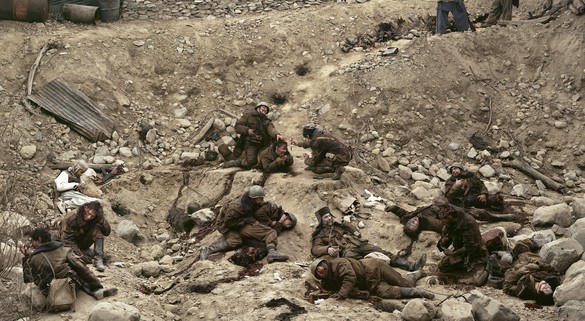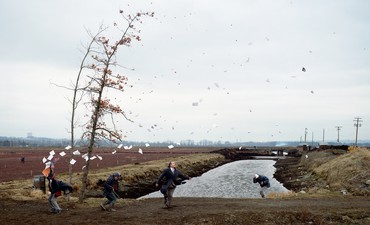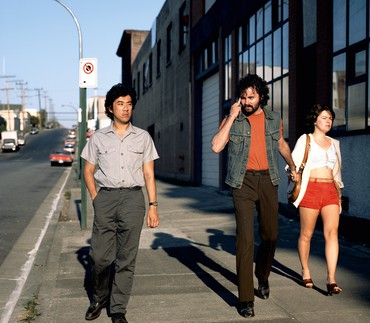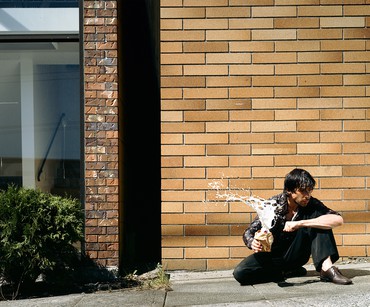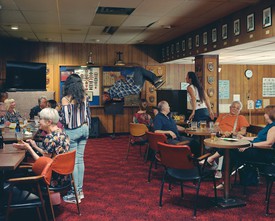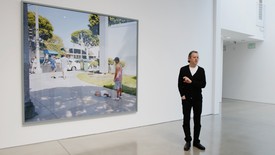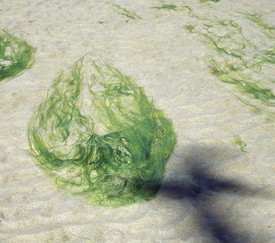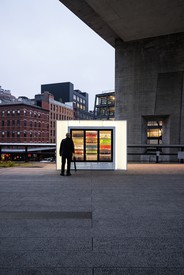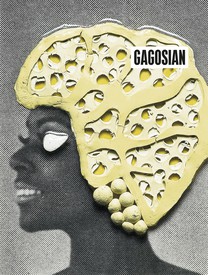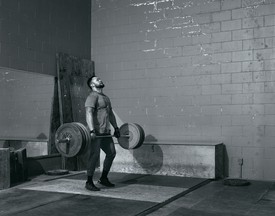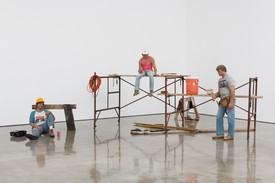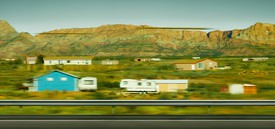
Daniel Spaulding is an assistant professor of modern and contemporary art at the University of Wisconsin, Madison. He previously worked in the curatorial department of the Getty Research Institute, Los Angeles. He is a founding editor of Selva: A Journal of the History of Art.
Blatant digital manipulation turned out to be a vanishing mediator in Jeff Wall’s art. He still uses digital tools, as does nearly any photographer working today. But no longer do they seem like the point of any of his pictures. It was not always thus: for a few years in the 1990s, computerized interventions were the most noticeable or at least the most novel aspect of the Canadian artist’s practice. I have in mind pictures such as A Sudden Gust of Wind (after Hokusai) (1993), which broadcasts nonoriginality in its title—it is indeed a digital collage based on a print by the Japanese master. Or, The Flooded Grave (1998–2000), in which a hole in the ground opens to a tidepool complete with sea anemones and like fauna, also plopped in via computer. Composition is emphatically in play in these works, and they flaunt a degree of subjective fantasy that photographs often avoid, or pretend to avoid. But then, why do photographs more usually flaunt their reality effects, their resistance to being just any odd thing their makers want them to be? That is, why do they so often insist on belonging to the world outside, in a stronger sense than most art? Why do questions of truth, ethics, and ontology (the nature of the medium and its connection to the real) loom so large in the canon of photo theory1 when painters can mostly go about their business without similar baggage?2 Wall’s career is one long answer.
The pictures to which I’ve referred have often, and persuasively, been construed as a turning point in that career. For example: the art historian Michael Fried identifies three major phases, pinned symmetrically around 1990–93. The first is that of Wall’s initial mature works, the big lightbox transparencies he started making in 1978, “whose fictional or staged or otherwise constructed aspects are in different ways positively announced.” The second is “a phase of far more spectacular or indeed ‘theatrical’ productions” in the early 1990s. And the last, from the mid-1990s onward, introduces “a quieter, more ‘realistic,’ above all more ordinary-seeming though nevertheless carefully constructed kind of picture.”3 This final stage probably deserves internal periodization of its own by now. In 2017–18, for example, Wall produced the astonishingly painting-like work Recovery, which picks up directly on issues of pictorial organization last probed by Georges Seurat and Henri Matisse. Whether a one-off or a sign of things to come, the picture marks a return to, or indeed an intensification of, the “authorial” mode of the artist’s earlier production. This is just one potential Wall’s method now permits, though, alongside the “quieter” track; there is no reason to dispute Fried’s overall chronology. But we do have reason to probe the timing of what Fried labels the “theatrical” interregnum, which all but begs to be interpreted as a symptomatic rupture.
The key pictures are these: Dead Troops Talk (a vision after an ambush of a Red Army patrol, near Moqor, Afghanistan, winter 1986) (completed in 1992, although work began as early as 1986, the date in the work’s subtitle); The Vampires’ Picnic (1991); and A ventriloquist at a birthday party in October 1947 (1990). In the context of Wall’s wider oeuvre these works are aberrant, or at least exceptional: all are hallucinatory images of the living dead.4 Two of the scenes are blatantly impossible. Dead Troops Talk is a “vision” (Wall does not explain whose) of Soviet soldiers killed by Afghani mujahideen. They speak, laugh, and roughhouse—unexpected behavior for the recently deceased. Of this work the artist has said, “I was going to advance a claim to authenticity that couldn’t be satisfied” (in this case, a claim to the authenticity of war photography, a privileged instance of the documentary mode since it records the most extreme of human experiences).5 The Vampires’ Picnic does much the same: it’s an elaborate blood-feast in the periurban periphery, the setting for many of the artist’s tableaux. A ventriloquist, finally, is odd in less over-the-top ways, but hardly less uncanny. The dummy is clearly a figure for art, and maybe Wall’s art in particular: it casts a spell by virtue of occupying the “uncanny valley” of close yet unconvincing similitude to life. The scene also happens to be a weirdly precise historical reenactment, weird because there is no reason why October 1947 should be a particularly significant date.6
Such compositional gambits contrast or even conflict with the sense that these scenes have not been arranged for us but rather that we have happened upon them in a delirious instant.
Of these three pictures, only Dead Troops Talk, the last completed and most ambitious, is in fact a digital composite. The other two all the same adopt a “cinematographic” procedure (Wall’s own term) that viewers may easily confuse with computerized postproduction, given the latter’s current omnipresence.7 Whether digital modification was actually in play or not is hence somewhat undecidable, at least without the benefit of extrapictorial data (such as the production notes in the artist’s catalogue raisonné). What is evident at first glance, though, and what persists in memory beyond the technical question (“Is it Photoshop or not?”), is an unusual plasticity and obtrusiveness of real or virtual mise-en-scène. The production of such photographs would have required elaborate staging either way. The tilting upward of the background in Dead Troops and the rhythmic arrangement of spotlit figures in Picnic make it clear that they have been arranged expressly for our eyes: these are devices of old-school history painting, the most prestigious genre of art until the later nineteenth century. Such compositional gambits contrast or even conflict with the sense that these scenes have not been arranged for us but rather that we have happened upon them in a delirious instant, to which attaches the embarrassment of seeing something we are not supposed to. Each projects a vision that is vividly present, full of minutely recorded incident, and that yet manifestly does not belong to the realm of the real. What we are seeing is the unrepresentable: death. Or, rather, undeath: a moment of illogical fluctuation between living and dead, a moment of unnatural reversal. The ventriloquist’s dummy is the sign of that.
It bears emphasizing that the photographs made immediately before this interregnum—the photos of the late 1970s and ’80s—had a different relationship with truth. The earliest of the lightboxes amounted to an inquiry into the workings of representation, in diagram-like images such as Picture for Women of 1979 (a work heavily influenced by psychoanalytic film theory—everything here is about the play of the gaze) or The Destroyed Room (1978), which cites Eugène Delacroix’s 1827 painting The Death of Sardanapalus. These are pictures very much of the sort that a smart young art-history professor might produce—no coincidence, since that is in fact what Wall was at the time.8
By the mid-1980s, though, his practice had mutated into something different: a full-fledged representational project. In fact, it was a specifically realist project, both in a philosophical sense and in its revival of the aims and to some extent the appearance of nineteenth-century realist painting. It was grounded in a belief not that representation could be transparent or unmediated (that a photograph could be a “message without a code,” in Roland Barthes’s memorable phrase) but rather that representation could have some link to its referent. And Wall had come to reject the varieties of postmodern antirealism that were all too current at the time:
To say, for example, that when I take a photograph of something, and then display that photograph, that the thing itself is made absent in the process and to say, moreover, that the reality of that thing is suppressed in its representation is to make an exaggerated, spurious “critical” or “political” point. We cannot remain at the level of this elementary formal paradox, which proves nothing about what is far more important, namely the ability of representation to be adequate in terms of meaning, to its referent, to its subject.9
Which seems reasonable enough. Isn’t that why we look at photographs in the first place? Wall aimed to realize this “adequacy” in staged images that, in this period, often had a socially conscious edge: pictures of neighbors gathering to witness a family turned out of their home (An Eviction, 1988/2004), or a seemingly momentary, though no less staged, racist gesture on the street (Mimic, 1982). His aim was to renew the “painting of modern life”—the painting of modern capitalist society—that Charles Baudelaire had called for in the middle of the previous century, and which, at least in some respects, the poet saw fulfilled in the paintings of his friend Édouard Manet (whose 1882 painting A Bar at the Folies-Bergère was Wall’s direct model in Picture for Women). Wall’s reference to Baudelaire was explicit:
Some of the problems set in motion in culture not only in the 1920s, but in the 1820s, and even in the 1790s, are still being played out, are still unresolved, we are still engaged in them. I guess that’s why, at a certain point, I felt that a return to the idea of la peinture de la vie moderne was legitimate. Between the moment of Baudelaire’s positioning this as a program and now, there is a continuity which is that of capitalism itself. . . . I feel I’m working within and with a dialectic of capitalism and anticapitalism, both of which have continuous histories within, and as, modernity.10
Hence Wall’s adoption of “capitalist realism,” to appropriate a term that artists in West Germany had concocted some years before.11 A realism of a long and unfinished epoch. The sticky wheel is this: Wall pursued his project in a medium then commonly judged to be already inherently realist. Photographs were supposed to be an imprint of whatever was in front of them and nothing more. One of Wall’s merits is to show that matters are more complicated, and he did so precisely in photographs meant only to fulfill that original pledge by a more circuitous route. What exactly did it mean to make “realist” photographs, then, when from a certain perspective it would seem he had little choice?
Let’s put the question differently. What do photographs do when they are not being “realistic”? One answer: not being photographic. They might indeed be painterly, or composed, calculated craft—ostentatious, as opposed to neatly self-effacing, about their own mediation. The cinematographic photo, then, whether computer assisted or not, is a photograph invaded by something else. Call it intention, perhaps. Or premeditation. Or even painting. And this is something the medium always held in store, though as a mostly unrealized potential, at least so long as the documentary ideal held good. Yet it was after all only a couple decades after Nicéphore Niépce, Louis Daguerre, and William Henry Fox Talbot invented the process (each in a different way) that Victorian photographers such as Henry Peach Robinson and Oscar Rejlander began making large-scale composite prints, a clear precedent for Wall’s early digital montages, if one he disallows.12 Photographs have always had it in their bones to metastasize into something other than a record of the real. In a moment of crisis, this foreign body that is other than the “that-has-been,” as Barthes described photography’s “noeme,” or most irreducible meaning, may burst forth, take over the whole surface of the picture. For Wall, the turn of the 1990s was such a moment.
What I’ve been saying is that Wall’s art involves a dance between photography and not-photography. These terms shouldn’t be taken as ontological—words for the essence or nature of the medium—but rather as historically freighted notions about the kind of intentionality involved in the making of photographs. Thanks to Wall, along with many other photographers working in a similarly “authorial” mode, some of these assumptions have faded: at least among art audiences, it is no longer controversial to say that photographs may diverge from the documentary truth. The omnipresence of digital photo-editing in mass culture (even before the meme-like proliferation of “fake news”) has further loosened whatever grip the real may have had on images. The real now operates, then, less as a regulative ideal than as a phantom of what photography used to be thought to be—thus leaving the medium, in a curious way, external to what was once considered its ontology. Yet photography, once presumed to be veracious, still trades on that reputation even when blatantly defying it. The afterlife of ontology—or rather of ideas about ontology, to put the old hegemony of the that-has-been at a further remove—is long.
Roughly, “photography,” in these historically specific terms, is contingency and the momentary: the unpredictable, the flash of the real, mechanical automatism, the click of the shutter. Henri Cartier-Bresson’s “decisive moment” marks the apex of this once powerful idea, though it was always just one notion of photography among others. (Man Ray’s Surrealist concoctions, or, in a related example, the careful artifice of fashion photography, represented different models.) In Milk (1984) the decisive moment is the spray of white liquid against the grid of a brick wall. In Mimic it’s the racist gesture, which as we’ve seen is a piece of play-acting under the photographer’s control. Not-photography is that control. It is composition, calculation, subjectivity; it is painting, but not only painting. When not-photography inserts itself into Wall’s photography, it is through the interjection of staging, allusion, politics—in short, of the artist’s intention, and of (coded) meaning. Conversely, when photography appears within the architecture of not-photography, it will often be as dumbness, blindness, or, at the limit, meaninglessness. It takes the absolute form of a stain, like the stain of a shadow on a wall, or on a silver film.13
What really emerged on the far side of the uncanny valley . . . was a return to the photographic itself, a turn to understated yet impeccably fictional verisimilitude.
Not-photography reaches its apex in the ghoulish pictures of 1990–93, which are “the painting of modern life” taken to a level of hypertrophy and self-parody. These pictures represent the climax and passing of the politicized truth-claims that had been crucial to Wall’s art in the 1980s. Those claims had not been founded on a naive belief in the camera’s mechanical veracity but rather on a conviction that all-too-real social relations require conscious mediation to become appearance—and that this is realism properly speaking, since it unmasks aspects of the real that might otherwise go unnoticed. Mimic, for instance, reproduces an offensive gesture that on the street would probably pass by too quickly for anyone to capture. Mimic is not-photography in the service of photography, so to speak—the point was to keep representation viable, not to deconstruct it into oblivion. The advent of digital manipulation, however, amounted to a further massive invasion of the not-photographic, pushing the 1980s model to the breaking point. This passage ran through the uncanny valley of hyperreality—the end of the “adequacy” of signifier to referent. What comes after? Inadequacy, perhaps.
The argument can be put less negatively. What really emerged on the far side of the uncanny valley, from about the second half of the 1990s on, was neither further grotesquery nor mourning for lost powers. It was, rather, a return to the photographic itself, a turn to understated yet impeccably fictional verisimilitude: Fried’s “quieter, more ‘realistic,’ above all more ordinary-seeming though nevertheless carefully constructed kind of picture.” (Although, as we have seen in the case of Recovery, this new emphasis did not preclude other possibilities.) This is not really all that different from what the realist strand in Western painting had been doing for centuries. What is remarkable is how belated photography was in achieving this status. It is not so much that Wall’s photographs ape paintings as that they aspire to function in the mode of post-Renaissance paintings precisely inasmuch as the latter are disenchanted, perspicuous about their condition both as the legatees of a primordial, near-magical mimetic charge and as modern, unmagical commodities among others. “Fictionality”—the fact, so straightforward and yet so tricky, that an authorial statement is neither true nor exactly a lie—is something paintings began to pull off in the sixteenth century, and literature even earlier, at least if we follow the art historian Christopher Wood.14 A modern secular portrait is different from a medieval icon of the Virgin Mary because the former is understood to be only a representation whereas the latter, to a believer anyway, provides direct access to the supernatural. Premodern artworks tended to be embedded in a world of cult, ritual, and magic. They were enchanted: an artwork was more than just an object on the wall, or a set of representational conventions. It is in this respect that the secular painting is, by contrast, disenchanted, that is, only an image rather than a vector of salvation or of magical causality. The strangeness of photography with respect to all other art forms is that despite being among the youngest of media, it partakes of the most archaic of mimetic faculties: the nearly inescapable sense that there is a physical (or, in semiotic terms, an indexical) link between the image and its referent—a direct instantiation of contagious magic, or of the notion that things once in contact remain in contact, even at a great distance. It is this link that Wall’s art begins to pick away at. This is what makes his work a chapter in the disenchantment of the world, against which the “liquid intelligence” of photography’s mimetic promiscuity mounts its resistance. In an essay called “Photography and Liquid Intelligence,” Wall notes that the literally liquid elements of photography, which are also the metaphorically liquid reserve of its nonhuman agency (to be literal again: the solutions and water used in developing analogue film), have steadily retreated from the medium’s technical process.15 Yet in good dialectical fashion they strike back. Mimesis always moves laterally, not in a line.
Take a work that is a conscious echo of Picture for Women, the quasi-documentary Vancouver, 7 December 2009: Ivan Sayers, costume historian, lectures at the University Women’s Club, Virginia Newton-Moss wears a British ensemble c. 1910, from Sayers’ collection (2009). It is what it says: a restaging of a lecture the artist actually saw, with the two figures playing themselves. The weirdness of the picture, which never quite evaporates, is that the living female model looks either more or less than living, half mannequin, half zombie, a vivification of the dummy in A ventriloquist at a birthday party in October 1947. A compact adjective I’ve already used for this quality is “uncanny,” and it fits. There are worlds of discourse to unspool here: Walter Benjamin’s insistent pairing of fashion with death in his Arcades Project (and the horrendous gender politics of that equation), for example.16
The point, though, is that the final product wears these concerns lightly, in a mise-en-scène that is entirely unconcerned with either the literal truth or the literal falsehood of the diegetic event. An event just is, whether staged or spontaneous. Here is a Nietzschean intensity of aesthetic untruth. It is also perhaps this intensity that makes art art. And finally, this intensity is deeply not-photographic. The noeme “that-has-been” is present yet unstressed here, in silent opposition to a century and more of the discourse of photography’s truth. The scene is ordinary yet a fiction, and comfortable with being fiction, something strange only because it is happening in photography. In this viewer’s experience at least, the dissonance involved (the scene occurred . . . and yet it didn’t occur) does not trouble its integrity in the way the more emphatic made-upness of Dead Troops Talk, for instance, upsets the tropes of war photography. That itself is the work’s new and subtler uncanniness: Wall’s photos can now “do” reality effects without even bothering about tipping their hand one way or another. They’ve learned to look at truth and lie “in a nonmoral sense,” to borrow from Nietzsche again.
As a particularly unnerving instance of what I’m talking about, take the 2011 work Boxing, an unintentionally resonant picture in the era of covid-19. Wall shows us a hermetically sealed modernist living room where two adolescents face off in boxing shorts and gloves. It could suggest either real estate staged to sell or a porn set; either way, it is not a place in which to live. Consider the weird incongruity, and the weird formalism, of the amateur boxing match, which seems lifted from an archaic Greek frieze. All of this is exceedingly artificial yet by no means monstrous, as is The Vampires’ Picnic (another picture that turns on the too evidently staged quality of the tableau). This is simply a thing photography can do now.
When and why did this happen? I have already suggested that the pictures of the ghoulish interregnum are a helpful pointer. They belong to a very special moment in history. Dead Troops Talk was conceived in the waning days of the Cold War and completed after its end. The Berlin Wall came down in 1989. This is also when images of the undead begin to proliferate in Wall’s art, making explicit the oft noted “zombielike” quality of his figures.17 A few years later—in 1998, specifically—The Simpsons ran an episode in which a cutaway gag reveals that the Soviet Union never really collapsed but was only biding its time for a counterattack: zombie Lenin punches out of his mausoleum, intoning the words “Must . . . crush . . . capitalism.”18 Jacques Derrida’s book Specters of Marx had appeared in 1993; here the French philosopher proposed “hauntology” as a replacement for old communist solidarities. It was Derrida’s first and only significant engagement with Marxist thought, after looking in other directions through the uprising of May ’68 and the “red decade” that followed. Hauntology is the ontology of ghosts, of traces, the only forms that century-long dreams of freedom could then take, it seems. It’s as if throughout the decade of the 1990s, the collapse of actually existing socialism remained difficult to believe, even for its bitterest enemies; as if the absence of any alternative to liberal capitalism—Francis Fukuyama’s famous end of history—could not quite tolerate itself, could not do without some specter, however ridiculous, haunting Europe (and everywhere else), to invoke the opening line of the Communist Manifesto.19 If Dead Troops Talk partakes of this cultural formation, the issues the picture raises are not just formal.
I am not exactly saying that the epistemology of the new postdigital photograph is keyed to the end of the Cold War, which likewise marked the passing of a specific, material opposition between politicized representation (the socialist realist model) and capitalist phantasmagoria. I am not saying we can exclude the possibility, either.20 It seems indisputable, at least, that after the collapse of the sclerotic socialist empire that had sent the dead troops off to die, there was no longer even a notional baseline of correct representation (the “anticapitalist” pole of the modern dialectic) against which Wall could play his distortions. Without such a baseline, all there is to see in any given picture is one specific perspective on the world, to which another may oppose itself with equal legitimacy—every perspective, then, laying claim to just as much of the real as the next, because the real is nothing but the concert and conflict of these points of view. And thus the total perspectivism of Wall’s newer work is at the same time a new realism (since there is now no other world to represent but this world, as Wall sees it).
The remainder in this division of the picture from reality is photography itself. For one thing, as we have seen, the medium’s tie to the real does not disappear in the flight to fantasy, nor in the more modest ambitions of the “ordinary-seeming” work that followed. It is likewise worth noting that, at the same time as Wall’s ever more proficient use of digital technology banished the “liquid” farther and farther from his practice, he was also moving in the opposite direction, toward a reengagement with photographic tradition. His partial turn toward standard photographic printing in the 1990s (where lightbox transparencies had earlier been his signature) is one sign of this, as is his limited but noteworthy production of unstaged “street” photographs from the same moment onward.21 But beyond the technical level, even, there remains the steady drip of photography (of the contingent, incalculable real) against the grid of not-photographic control. More subtly now than in the 1980s, photography becomes a persistent source of uncertainty and dialogue within the apparently unified fabric of the image. Above all, it remains external to the artist’s agency, though not perhaps to agency altogether: “In photography, the liquids study us, even from a great distance,” Wall writes.22 What if photography is something that arrives in Wall’s art from the outside? What if it’s nothing but the Outside as such?
1See, most importantly, Roland Barthes, Camera Lucida, trans. Richard Howard (New York: Hill & Wang, 1981), and Susan Sontag, On Photography (New York: Farrar, Straus and Giroux, 1977). Another important factor is the theorization of photography as an “indexical” medium in the work of Rosalind Krauss and others. See in particular Krauss, “Notes on the Index: Part 1” and “Notes on the Index: Part 2,” in The Originality of the Avant-Garde and Other Modernist Myths (Cambridge, MA, and London: The MIT Press, 1985), pp. 196–220. There have been strong counterproposals to the above, for example John Tagg’s argument that photography has no essential identity but is instead constituted solely by the regimes of power and knowledge that surround it (Tagg, The Burden of Representation: Essays on Photographies and Histories [Amherst: University of Massachusetts Press, 1988]), or George Baker’s that photography has come to occupy an “expanded field” not unlike the condition of post-Minimalist art (Baker, “Photography’s Expanded Field” October 114 [Autumn 2005], pp. 120–40). But neither these nor unorthodox interventions by Vilém Flusser (Towards a Philosophy of Photography, trans. Anthony Mathews [London: Reaktion Books, 2000]), Kaja Silverman (The Miracle of Analogy: Or, the History of Photography, Part 1 [Stanford, CA: Stanford University Press, 2015]), Ariella Azoulay (The Civil Contract of Photography [New York: Zone Books, 2008]), and François Laruelle (The Concept of Non-Photography, trans. Robin Mackay [Cambridge, MA, and London: The MIT Press, 2011]), among others, have thus far really provided photo theory with a new orientation—by which I just mean that Sontag and Barthes are sure to anchor any syllabus on the topic.
2I am not saying that painters are unconcerned with the nature of their medium. Far from it! But there is a specific way in which photography has from its beginning been concerned with the problem of what photography is—perhaps because photography has a specific, datable beginning, unlike most art forms, and furthermore because of its obvious and innate mimetic exactitude. Over the long run this concern has proven foundational in a way that, for example, Clement Greenberg’s modernist account of painting’s “flatness” (to name the strongest ontological claim ever made for the medium) has not. What I am saying is simply that, with the exception of certain highly charged material (think of the uproar over Dana Schutz’s painting of Emmett Till’s mangled body, shown at the Whitney Biennial in 2017—and think of the total lack of moral concern with the subject matter of any of her other works), painters can paint whatever they want. Photography discourse circles around the ethics of representation in a different and more intense way. Sontag is the key reference here.
3Michael Fried, Why Photography Matters as Art as Never Before (New Haven, CT: Yale University Press, 2008), p. 63.
4Tom Holert, for instance, writes, “The years of 1991 and 1992 mark an interlude in Jeff Wall’s work. One could also call them the years of the digital grotesque.” “Interview with a Vampire: Subjectivity and Visuality in the Works of Jeff Wall,” in Jeff Wall: Photographs, exh. cat. (Vienna: mumok, 2003), p. 128. Wall himself concurs: “A picture like The Vampires’ Picnic was an experiment with or an attempt at a comic allegory. That was a direction, or an impulse, which I value but which I don’t feel I’ll go much further with, unless the mood strikes me again.” Wall, quoted in David Rimanelli, “Entries,” in Artforum 41, no. 3 (November 2002), p. 41. I cannot in fact think of a more recent work that approximates the same “mood.”
5Wall, in Craig Burnett, “Interview,” in Burnett, Jeff Wall (London: Tate Publishing, 2005), p. 59.
6The party in the photo is clearly for a somewhat older child than Wall would have been in 1947; he was born on September 29, 1946.
7Wall, in Burnett, “Interview,” p. 59.
8Wall had earned a master’s degree in art history at the University of British Columbia in 1970, then studied at the Courtauld Institute of Art, London, for the next three years, before returning to his native Vancouver, where he taught at the University of British Columbia, Simon Fraser University, and the Vancouver School of Art (since renamed the Emily Carr University of Art and Design).
9Wall, “Representation, Suspicions, Critical Transparency,” in Jeff Wall: Selected Essays and Interviews (New York: The Museum of Modern Art, 2007), pp. 209–10.
10Ibid., p. 208.
11Namely Konrad Lueg, Sigmar Polke, and Gerhard Richter, who staged an exhibition and performance by this name in Düsseldorf in 1963.
12In an interview with James Rondeau in Peter Galassi, Jeff Wall, exh. cat. (New York: The Museum of Modern Art, 2007), Wall dismisses Henry Peach Robinson, Oscar Rejlander, and the other early exponents of combination printing by saying that instead of imitating the worst “Salon trash” they should have been imitating Edgar Degas.
13Or the mark of a crushed centipede on a wall in Alain Robbe-Grillet’s 1957 novel La Jalousie.
14Christopher Wood, “Countermagical Combinations by Dosso Dossi,” RES: Anthropology and Aesthetics 49/50 (Spring–Autumn 2006), pp. 151–70.
15Wall, “Photography and Liquid Intelligence,” in Jean-François Chevrier and James Lingwood, Un Autre Objectivité/Another Objectivity, exh. cat. (Milan: Idea Books, 1989), pp. 231–32. Repr. in Selected Essays and Interviews, pp. 109–10.
16Walter Benjamin, The Arcades Project, trans. Howard Eiland and Kevin McLaughlin (Cambridge, MA: Belknap Press, 1999), pp. 62-63.
17Citations could be multiplied here. David Campany, for example, writes, “Jeff Wall’s art is on some level an art of zombies.” Campany, “‘A Theoretical Diagram in an Empty Classroom’: Jeff Wall’s Picture for Women,” Oxford Art Journal 30, no. 1 (2007), p. 25.
18“Simpson Tide,” The Simpsons, season 9, episode 8 (first screened March 29, 1998).
19See Francis Fukuyama, The End of History and the Last Man (New York: Free Press, 1992).
20This suspicion is not mine alone. My interpretation of Dead Troops Talk is largely in agreement with that of Terry Atkinson, who writes that the picture is “an allegory of the death of the Red Army,” and thus of the “capitalist experience of the disintegration of communism.” Atkinson and Wall, Jeff Wall: Dead Troops Talk (Basel: Wiese Verlag, 1993), p. 29. The art historian Thomas Crow similarly calls Dead Troops Talk an “allegory about the end of the Cold War,” although he does not explain how or why. Crow, “Profane Illuminations,” in Modern Art and the Common Culture (New Haven, CT: Yale University Press, 1996), p. 168.
21A still earlier example that sticks out precisely for being so un-Wall-like is An Encounter in the Calle Valentín Goméz Farías, Tijuana (1991), which the artist’s catalogue raisonné lists as a “cinematographic photograph” without digital montage. The term “cinematographic photograph” indicates some degree of staging, but the work’s unusual site of production (Mexico, as opposed to the Vancouver locations that account for the vast majority of Wall’s pictures) and relatively unstructured appearance evoke the rhetoric of street photography. The work depicts a chicken and a dog looking at each other across a steep, unpaved, fiercely sunlit rubble-strewn street. The artist has said he thought the picture could have an “interesting, fable-like effect.” Wall, untitled statement, 1991, repr. in Jeff Wall: Catalogue Raisonné 1978–2004 (Göttingen: Steidl, 2005), p. 336.
22Wall, “Photography and Liquid Intelligence,” p. 110.
Artwork © Jeff Wall
